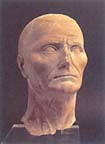 "A new exhibit at the National Museum of Western Art in Tokyo features Roman funerary sculpture gleaned from the collection of the Vatican Museum. The tradition of funerary portraiture grew out of elite practices during the years predating Augustus' epochal Pax Romana, the era of (relative) peace brought about by Roman domination of the Mediterranean region. In those early years -- the literary heyday of Rome (the first century B.C. produced Virgil, Horace, Ovid and Livy) -- wax portraits known as imagines would be paraded in the funeral processions of the upper classes. These would then be displayed, perhaps alongside portraits or busts in bronze, marble or terracotta, in the lararium (household shrine), not unlike the way photographs of ancestors are displayed to this day on the butsudan (family altar) in many Japanese homes.
"A new exhibit at the National Museum of Western Art in Tokyo features Roman funerary sculpture gleaned from the collection of the Vatican Museum. The tradition of funerary portraiture grew out of elite practices during the years predating Augustus' epochal Pax Romana, the era of (relative) peace brought about by Roman domination of the Mediterranean region. In those early years -- the literary heyday of Rome (the first century B.C. produced Virgil, Horace, Ovid and Livy) -- wax portraits known as imagines would be paraded in the funeral processions of the upper classes. These would then be displayed, perhaps alongside portraits or busts in bronze, marble or terracotta, in the lararium (household shrine), not unlike the way photographs of ancestors are displayed to this day on the butsudan (family altar) in many Japanese homes.
Roman funerary monuments from the third century and fourth century A.D. show declining levels of artistic skill.
One of the most powerful pieces here is the head of a terracotta votive statue dating from the first quarter of the first century A.D.; the face is aquiline and patrician, seeming to anticipate the so-called hieratic style of later centuries. Or, rather, hieratic representation, which evolved in the third century, was a conscious effort to recapture the stylistic purity of such early Roman sculpture, after two centuries of cheerfully expressive but unrefined representation -- as exemplified by those tradesmen's funerary friezes. "
No comments:
Post a Comment